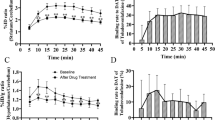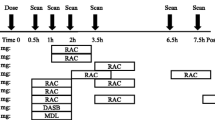Abstract
Introduction
Mirtazapine is a racemic antidepressant with a multireceptor profile. Previous studies have shown that the enantiomers of mirtazapine have different pharmacologic effects in the brain of laboratory animals.
Materials and methods
In the present study, we used positron emission tomography (PET) and autoradiography to study effects of (R)- and (S)-[11C]mirtazapine in the human brain. Detailed brain imaging by PET using three methods of kinetic data analysis showed no reliable differences between regional binding potentials of (R)- and (S)-[11C]mirtazapine in healthy subjects.
Results
Autoradiographic studies carried out in whole hemispheres of human brain tissue showed, however, that (R)- and (S)-mirtazapine differ markedly as inhibitors of [3H]clonidine binding at α2-adrenoceptors.
Conclusion
The multireceptor binding profiles of mirtazapine enantiomers, along with individual differences between subjects, may preclude PET neuroimaging from demonstrating reliable differences between the regional distribution and binding of (R)- and (S)-[11C]mirtazapine in the living human brain.



Similar content being viewed by others
References
Callado LF, Meana JJ, Grijalba B, Pazos A, Sastre M, Garcia-Sevilla JA (1998) Selective increase of alpha2A-adrenoceptor agonist binding sites in brains of depressed suicide victims. J Neurochem 70:1114–1123
Collignon A, Maes F, Delaere D, Vandermeulen D, Suetens P, Marchal G (1995) Automated multimodality image registration using information theory. In: Bizais Y, Barillot C, DiPaola R (eds) Information processing in medical imaging. Kluwer, Dordrecht, pp 263–274
Collins DL, Neelin P, Peter TM, Evans AC (1994) Automatic 3D intersubject registration of MR volumetric data in standardized Talairach space. J Comput Assist Tomogr 18:192–205
Comtat C, Bataille F, Michel C, Jones JP, Sibomana M, Janeiro L, Frebossen R (2004) OSEM-3D reconstruction strategies for the ECAT HRRT. Nuclear Science Symposium Conference Record, 2004. IEEE 6:3492–3496
de Boer T (1996) The pharmacologic profile of mirtazapine. J Clin Psychiatry 57(Suppl 4):19–25
de Boer TH, Maura G, Raiteri M, de Vos CJ, Wieringa J, Pinder RM (1988) Neurochemical and autonomic pharmacological profiles of the 6-aza-analogue of mianserin, Org 3770 and its enantiomers. Neuropharmacology 27:399–408
de Boer T, Nefkens F, van Helvoirt A (1994) The alpha2-adrenoceptor antagonist Org 3770 enhances serotonin transmission in vivo. Eur J Pharmacol 253:R5–R6
de Jong HW, van Velden FH, Kloet RW, Buijs FL, Boellaard R, Lammertsma AA (2007) Performance evaluation of the ECAT HRRT: an LSO-LYSO double layer high resolution, high sensitivity scanner. Phys Med Biol 52:1505–1526
Devoto P, Flore G, Pira L, Longu G, Gessa GL (2004) Mirtazapine-induced corelease of dopamine and noradrenaline from noradrenergic neurons in the medial prefrontal and occipital cortex. Eur J Pharmacol 487:105–111
Folstein MF, Folstein SE, McHugh PR (1975) “Mini-mental state”. A practical method for grading the cognitive state of patients for the clinician. J Psychiatr Res 12:189–198
Haddjeri N, Blier P, de Montigny C (1996) Effect of the alpha-2 adrenoceptor antagonist mirtazapine on the 5-hydroxytryptamine system in the rat brain. J Pharmacol Exp Ther 277:861–871
Hall H, Halldin C, Farde L, Sedvall G (1998) Whole hemisphere autoradiography of the postmortem human brain. Nucl Med Biol 25:715–719
Hall H, Hurd Y, Pauli S, Halldin C, Sedvall G (2001) Human brain imaging post-mortem— whole hemisphere technologies. Int Rev Psychiat Res Meth Biol Psychiat 13:12–17
Kooyman AR, Zwart R, Vanderheijden PM, Van Hooft JA, Vijverberg HP (1994) Interaction between enantiomers of mianserin and ORG3770 at 5-HT3 receptors in cultured mouse neuroblastoma cells. Neuropharmacology 33:501–507
Lammertsma AA, Hume SP (1996) Simplified reference tissue model for PET receptor studies. NeuroImage 4:153–158
Logan J, Fowler JS, Volkow ND, Wang GJ, Ding YS, Alexoff DL (1996) Distribution volume ratios without blood sampling from graphical analysis of PET data. J Cereb Blood Flow Metab 16:834–840
Marthi K, Bender D, Gjedde A, Smith D (2002) [11C]Mirtazapine for PET neuroimaging: radiosynthesis and initial evaluation in the living porcine brain. Eur Neuropsychopharmacol 12:427–432
Marthi K, Jakobsen S, Bender D, Hansen SB, Smith SB, Hermansen F, Rosenberg R, Smith DF (2004) [N-methyl-11C]Mirtazapine for positron emission tomography neuroimaging of antidepressant actions in humans. Psychopharmacology (Berl) 174:260–265
Montgomery SA, Baldwin DS, Blier P, Fineberg NA, Kasper S, Lader M, Lam RW, Lepine JP, Moller HJ, Nutt DJ, Rouillon F, Schatzberg AF, Thase ME (2007) Which antidepressants have demonstrated superior efficacy? A review of the evidence. Int Clin Psychopharmacol 22:323–329
Piletz JE, Ordway GA, Zhu H, Duncan BJ, Halaris A (2000) Autoradiographic comparison of [3H]-clonidine binding to non-adrenergic sites and alpha2-adrenergic receptors in human brain. Neuropsychopharmacology 23:697–708
Piletz JE, Ordway GA, Rajkowska G, Zhu H, Klimek V, Swilley S, Duncan BJ, May W, Halaris AE (2003) Differential expression of alpha2-adrenoceptor vs. imidazoline binding sites in postmortem orbitofrontal cortex and amygdala of depressed subjects. J Psychiatr Res 37:399–409
Sled JG, Zijdenbos AP, Evans AC (1998) A nonparametric method for automatic correction of intensity nonuniformity in MRI data. IEEE Trans Med Imaging 17:87–97
Smith DF, Jakobsen S (2007) Stereoselective neuroimaging in vivo. Eur Neuropsychopharmacol 17:507–522
Smith DF, Dyve S, Minuzzi L, Jakobsen S, Munk OL, Marthi K, Cumming P (2006a) Inhibition of [11C]mirtazapine binding by alpha2-adrenoceptor antagonists studied by positron emission tomography in living porcine brain. Synapse 59:463–471
Smith DF, Marthi K, Munk OL, Cumming P, Hansen SB, Jakobsen S (2006b) PET neuroimaging of [11C]mirtazapine enantiomers in pigs. Eur Neuropsychopharmacol 16:350–357
Szegedi A, Schwertfeger N (2005) Mirtazapine: a review of its clinical efficacy and tolerability. Expert Opin Pharmacother 6:631–641
Tomita M (1988) Significance of cerebral blood volume. In: Tomita, M, Sawada, T, Naritomi H, Heiss, WD (eds) Cerebral hyperemia and ischemia: from the standpoint of cerebral blood volume. Elsevier Science, Amsterdam, pp 3–31
Unnerstall JR, Kopajtic TA, Kuhar MJ (1984) Distribution of alpha2 agonist binding sites in the rat and human central nervous system: analysis of some functional, anatomic correlates of the pharmacologic effects of clonidine and related adrenergic agents. Brain Res 319:69–101
Wikstrom HV, Mensonides-Harsema MM, Cremers TI, Moltzen EK, Arnt J (2002) Synthesis and pharmacological testing of 1,2,3,4,10,14b-hexahydro-6-methoxy-2-methyldibenzo[c,f]pyrazino[1,2-a]azepine and its enantiomers in comparison with the two antidepressants mianserin and mirtazapine. J Med Chem 45:3280–3285
Zhou Y, Endres CJ, Brasic JR, Huang SC, Wong DF (2003) Linear regression with spatial constraint to generate parametric images of ligand-receptor dynamic PET studies with a simplified reference tissue model. Neuroimage 18:975–989
Zigmond AS, Snaith RP (1983) The hospital anxiety and depression scale. Acta Psychiatr Scand 67:361–370
Acknowledgments
We thank Organon, Oss, Holland for generous supplies of unlabeled mirtazapine enantiomers, Alexandra Tylec of Karolinska Institutet for help with autoradiographic experiments, and the Danish Medical Research Council for financial support. The authors have no conflicts of interest related to these research findings.
Author information
Authors and Affiliations
Corresponding author
Rights and permissions
About this article
Cite this article
Smith, D.F., Hansen, S.B., Jakobsen, S. et al. Neuroimaging of mirtazapine enantiomers in humans. Psychopharmacology 200, 273–279 (2008). https://doi.org/10.1007/s00213-008-1208-6
Received:
Accepted:
Published:
Issue Date:
DOI: https://doi.org/10.1007/s00213-008-1208-6




